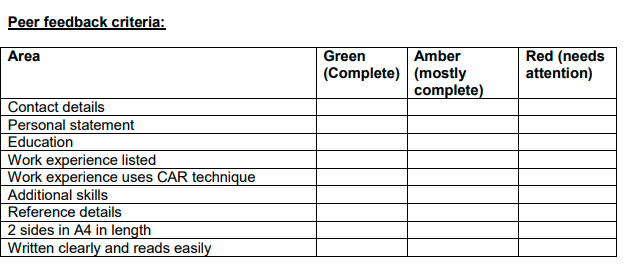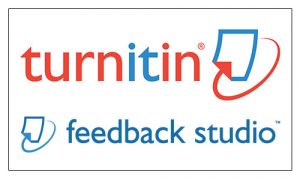Delivering Peer Review Online
In student peer review, students review other students’ work and provide feedback on it. The learning benefits of such processes for students are well documented. In this case study, Miriam Firth & Bobbie Dutton from SEED explain how they adapted their previously face to face peer assessment in-class task for blended delivery.
What was the teaching and learning problem?
Students are required to submit their CV as part of the assessment for the unit. In face-face teaching we would ask the students to print out and bring their CVs into class. With these they would engage in some peer review of the CVs to provide feedback and also to encourage reflection which in turn should improve their own CVs.
With the move to blended delivery during Covid-19 we needed to find an alternative method of facilitating peer review.
How did you solve it?
We used the PeerMark tool within Feedback Studio (formerly Turnitin). Students uploaded their own CVs as usual, and then an additional peer review assignment was created where students were required to review 1 other paper and provide feedback.
The following clarifies the instructions to students and the marking criteria applied.
Instructions to students
In preparation for your ASP applications and future Employability it is important that you consistently update and refine your Curriculum Vitae. Using the activities and discussion offered in week 3s class please update and submit your CV and upload it for review and feedback.

We used a traffic light system of grading using the question tools within the PeerMark assignment tool.
Students submitted their CVs on the 5th of November 2020. The peer review then took place in the students’ timetabled class on Monday the 9th of November between 9-11am. To support students conducting the peer review in class the following actions were completed;
- We created a Turnitin assignment space for students to submit their CVs.
- We made a peer review assignment which then linked to the Turnitin assignment space where students submitted their original CVs.
- We wanted to check that the Turnitin peer review assignment would work before the class, so on the Friday after CV submission and before the peer review session, we hosted a trial run with 3 students. In this we asked them to access Blackboard and try to open one of the submitted CVs for review. This ensured we were aware that students could access the Turnitin peer review assignment.
- We asked a volunteer to take screen shots of the process from the students’ view which we then incorporated into a Google Docs to visually guide students through the peer review process. To view this google doc please follow this link: https://docs.google.com/document/d/1qfPbzeYidTPFj8MCI5sbOJB9-qrOg4reSAmfpWcLnKU/edit
The peer review took place during a synchronous session. Students used the Google Doc with screenshots to guide them through the peer review. All peer reviews were conducted anonymously. The peer review and comments were then released to students on the following day.
What issues did you not anticipate? How did you resolve them?
- Two Turnitin assignments needed to be created for 1 peer review – 1 for the original CV submission, and then another for students to conduct the peer review.
- We could not access the students’ view of Blackboard to understand and see how the peer review would work from their side – meeting completed the week before and screenshots taken from the students.
- Not all students attended the peer review session, so there were some CVs which were not peer reviewed – we marked these on the afternoon after the session to ensure every student had feedback for the release date.
Evaluation / Student Feedback
Student 1 – I found it helpful to be able to have a look at other people’s work because it made me feel reassured that my work was of the same standard as others. This is good at the moment because you can sometimes feel a bit on your own so it is nice to be able to see what others are doing.
Student 2 – When I looked at my classmate’s CV, I realized that my CV was incomplete. I learned a few things that my peers did well and then applied them to m CV. At the same time, I pointed out the ways in which I had told my partner that we were different. I think this activity is very helpful for us to modify and improve our CV
Student 3 – Sharing work experience with peers are really meaningful and helpful, it not only give me opportunity to tell my story, but also let me share my point of view related to the job.
Student 4 – I found it more than useful to see what other people did, because sometimes it might be hard to determine what you want to do, or you might feel like you’re not good enough yet. It is really motivating to see that other students managed to secure interesting ASP’s.
Benefits
Expected benefits
- We were still able to run the peer review session.
- Peer reviewing others CVs led to improvements in their own CV development and critical analysis of their own CV.
- The feedback was quicker than normal submissions.
Actual benefits
- Expected benefits were achieved.
- We were able to see the process from the students’ view which enabled us to understand how these forms of assignment can best work.
- Students gained an insight into how marking is completed on Blackboard.
Top Tips
Make sure you consider the type of feedback you want students to give. PeerMark allows both free text and scaled question types. Scales are very useful for questions that ask how well something was achieved. Try to make the feedback scales/marking criteria student friendly, like the traffic light system used in this example.
Regardless of the question type students will need some guidance on how to evaluate their peer’s submissions. This can be discussed in a session prior to the evaluation or can become part of the peer review process itself.
Check that the peer review will work before the session or the time allocated for the peer review (like the check we did the Friday before).
Make sure you have time set aside after the session to be able to mark those submissions which have not been peer reviewed in class due to lower than expected attendance.
This peer review was a formative assessment. Caution is noted for any summative peer review as students could receive feedback and marks which might be more likely to be challenged. If using peer review for summative work the moderation process will also need to be more comprehensive for parity and fairness in the marks.
Other relevant info
The CV was already completed, this was not a new form of assignment. A two hour class had been delivered on CV format and presentation to the whole cohort in advance. Both of these points meant that students knew the expectations for a CV and that these expectations were all the same.



0 Comments